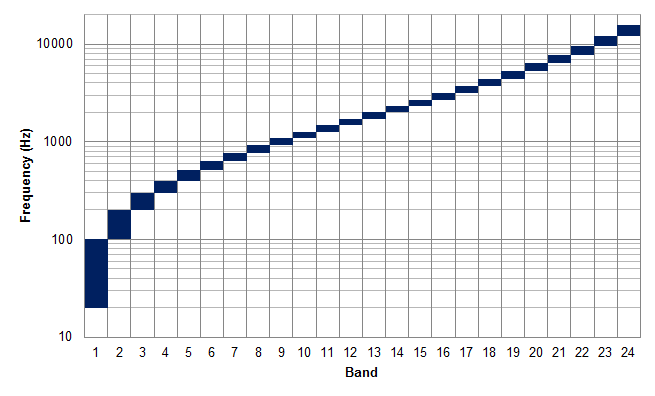Bark scale on:
[Wikipedia]
[Google]
[Amazon]
The Bark scale is a psychoacoustical scale proposed by Eberhard Zwicker in 1961. It is named after
Subdivision of the audible frequency range into critical bands
" ''The Journal of the Acoustical Society of America'', Volume 33, Issue 2, p. 248 (1961) One definition of the term is "...a frequency scale on which equal distances correspond with perceptually equal distances. Above about 500 Hz this scale is more or less equal to a logarithmic frequency axis. Below 500 Hz the Bark scale becomes more and more linear." The scale ranges from 1 to 24 and corresponds to the first 24
 Since the direct measurements of the critical bands are subject to error, the values in this table have been generously rounded.
In his letter "Subdivision of the Audible Frequency Range into Critical Bands", Zwicker states:
Since the direct measurements of the critical bands are subject to error, the values in this table have been generously rounded.
In his letter "Subdivision of the Audible Frequency Range into Critical Bands", Zwicker states:
Sonification seminar – 10/9/03
, ''CCRMA.Stanford.edu''.
:
Smith and Abel – Bark and ERB Bilinear Transforms (1999)
{{DEFAULTSORT:Bark Scale Scales Psychoacoustics 1961 in science 1961 in Germany
Heinrich Barkhausen
Heinrich Georg Barkhausen (2 December 1881 – 20 February 1956), born in Bremen, was a German physicist.
Growing up in a patrician Bremen family, he showed interest in natural sciences from an early age. He studied at the Technical Univers ...
who proposed the first subjective measurements of loudness.Zwicker, E. (1961),Subdivision of the audible frequency range into critical bands
" ''The Journal of the Acoustical Society of America'', Volume 33, Issue 2, p. 248 (1961) One definition of the term is "...a frequency scale on which equal distances correspond with perceptually equal distances. Above about 500 Hz this scale is more or less equal to a logarithmic frequency axis. Below 500 Hz the Bark scale becomes more and more linear." The scale ranges from 1 to 24 and corresponds to the first 24
critical band In audiology and psychoacoustics the concept of critical bands, introduced by Harvey Fletcher in 1933 and refined in 1940, describes the frequency bandwidth of the "auditory filter" created by the cochlea, the sense organ of hearing within the in ...
s of hearing
Hearing, or auditory perception, is the ability to perceive sounds through an organ, such as an ear, by detecting vibrations as periodic changes in the pressure of a surrounding medium. The academic field concerned with hearing is audit ...
.
It is related to, but somewhat less popular than, the mel scale
The mel scale (after the word '' melody'')
is a perceptual scale of pitches judged by listeners to be equal in distance from one another. The reference point between this scale and normal frequency measurement is defined by assigning a perc ...
, a perceptual scale of pitches judged by listeners to be equal in distance from one another.
Bark scale critical bands
 Since the direct measurements of the critical bands are subject to error, the values in this table have been generously rounded.
In his letter "Subdivision of the Audible Frequency Range into Critical Bands", Zwicker states:
Since the direct measurements of the critical bands are subject to error, the values in this table have been generously rounded.
In his letter "Subdivision of the Audible Frequency Range into Critical Bands", Zwicker states:
"These bands have been directly measured in experiments on the threshold for complex sounds, on masking, on the perception of phase, and most often on the loudness of complex sounds. In all these phenomena, the critical band seems to play an important role. It must be pointed out that the measurements taken so far indicate that the critical bands have a certain width, but that their position on the frequency scale is not fixed; rather, the position can be changed continuously, perhaps by the ear itself."Thus the important attribute of the Bark scale is the width of the critical band at any given frequency, not the exact values of the edges or centers of any band.
Conversions
To convert a frequency ''f'' (Hz) into Bark use: : or (Traunmüller, 1990) : or (Wang, Sekey & Gersho, 1992), ''CCRMA.Stanford.edu''.
See also
* Luminosity function, which describes the average sensitivity of the human eye to ''light'' of different wavelengths. * Fletcher–Munson curves * Equivalent rectangular bandwidth, the ERB scale *Critical bands In audiology and psychoacoustics the concept of critical bands, introduced by Harvey Fletcher in 1933 and refined in 1940, describes the frequency bandwidth of the "auditory filter" created by the cochlea, the sense organ of hearing within the inner ...
References
External links
*Smith and Abel – Bark and ERB Bilinear Transforms (1999)
{{DEFAULTSORT:Bark Scale Scales Psychoacoustics 1961 in science 1961 in Germany